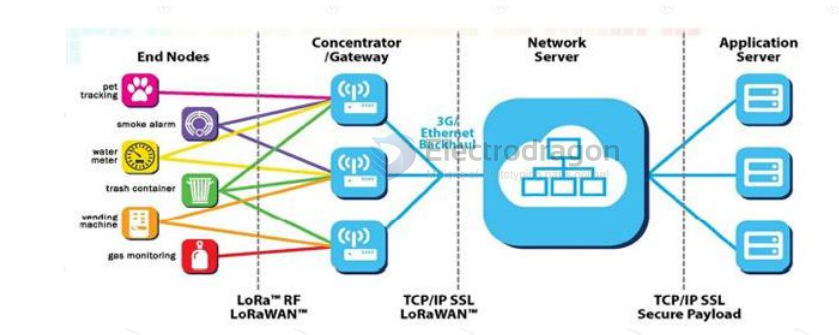Difference between revisions of "Category:LoraWAN"
(No difference)
|
Latest revision as of 15:07, 10 June 2021
Class
The LoRa Alliance is an open, non-profit organization led by Semtech in March 2015. The Alliance released a low-power wide-range based on the open source MAC layer protocol. LAN standard: LoRaWAN protocol standard. Network topology: star structure Network composition: LoRa module, gateway (Gateway or base station), Server (including Network Server, Network control, Application Server).
LoRaWAN divides LoRa nodes into three categories: A/B/C:
Two-way transmission terminal (Class A):
The Class A terminal will follow two short downlink receiving windows immediately after each uplink to achieve two-way transmission. The terminal arranges transmission time slots based on its own communication requirements, with small changes on the basis of random time (that is, the ALOHA protocol). This Class A operation provides the application with the lowest power consumption terminal system, and only requires the application to perform the server's downlink transmission within a short period of time after the terminal's uplink transmission. Downlink transmission by the server at any other time has to wait for the next uplink of the terminal.
Two-way transmission terminal (Class B) with designated receiving time slot:
Class B terminals will have more receiving time slots. In addition to the random receiving window of Class A, Class B devices will also open other receiving windows at the specified time. In order for the terminal to open the receiving window at a specified time, the terminal needs to receive a beacon for time synchronization from the gateway. This allows the server to know when the terminal is in the listening state.
Two-way transmission terminal (Class C) that maximizes the receiving time slot:
The Class C terminal basically keeps the receiving window open all the time, and only closes it briefly when sending. Class C terminals consume more power than Class A and Class B, but at the same time, the time delay from the server to the terminal is the shortest.
Brief
The complete LoraWan network system consists of: nodes, gateways, Lora NetWork Server, and application servers.
- The nodes are generally designed by LoRa chip;
- the gateway is designed by SX1301 provided by semtech;
- Lora NetWork Server now has open source loraserver or commercial TTN (The ThingsNetwork), users can build by themselves;
- the application server is designed and developed by users and is mainly used to exchange application data with Lora NetWork Server.
This category currently contains no pages or media.

